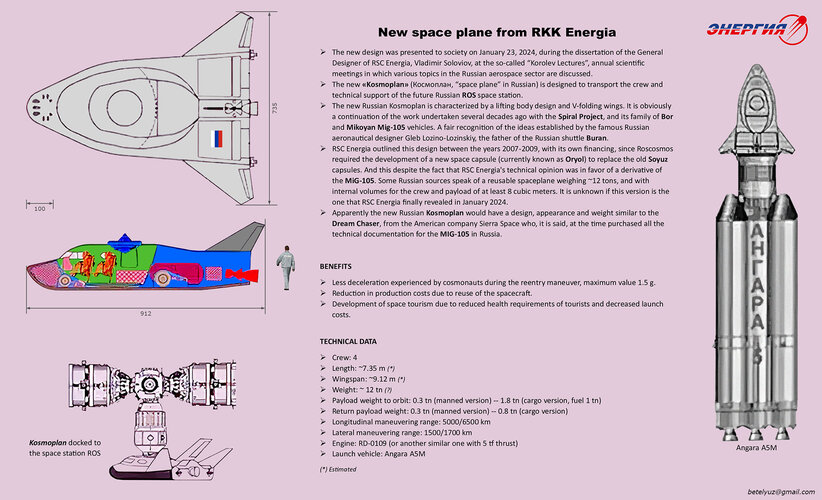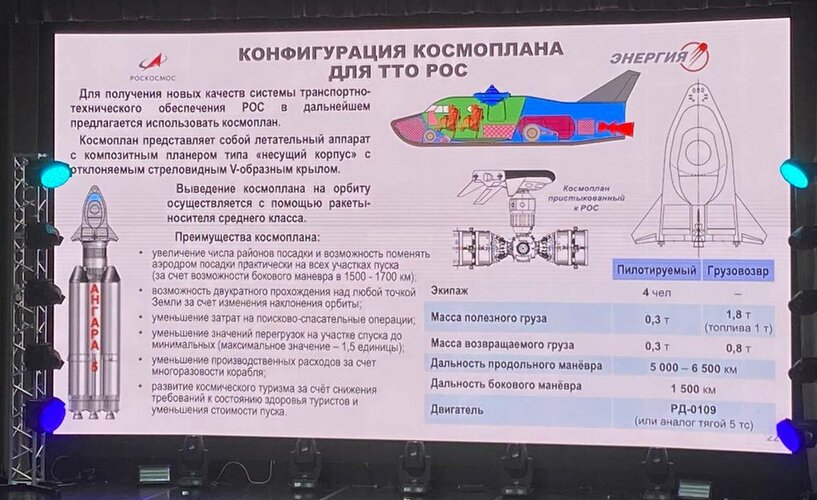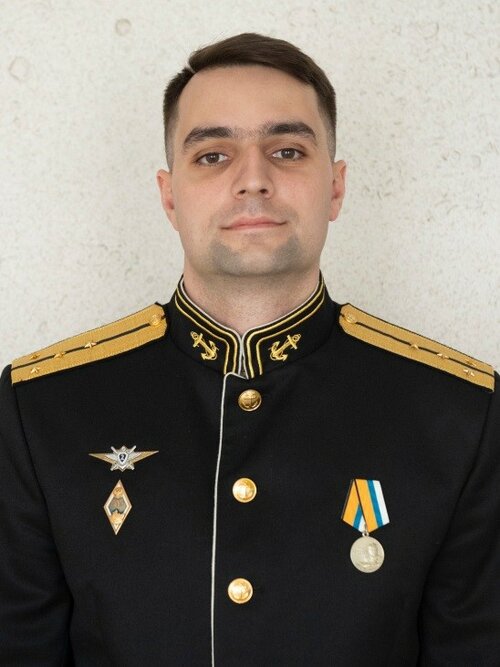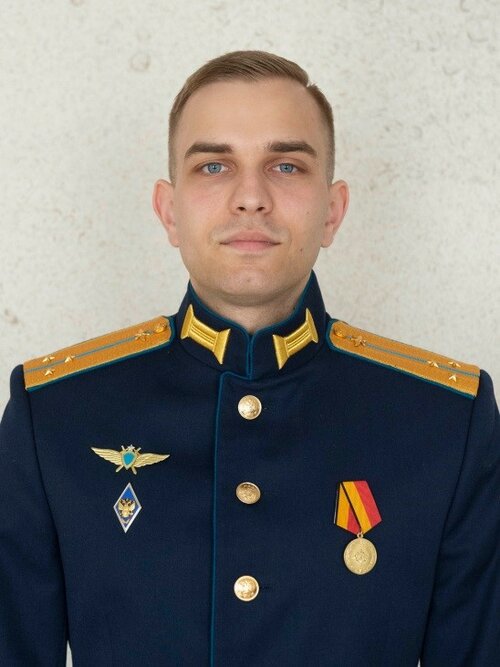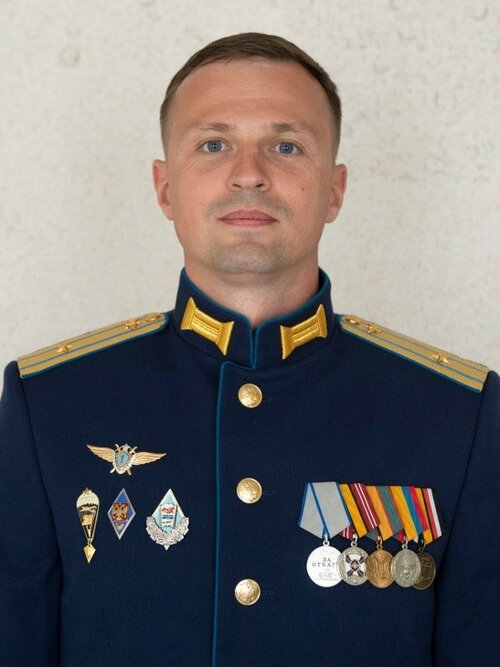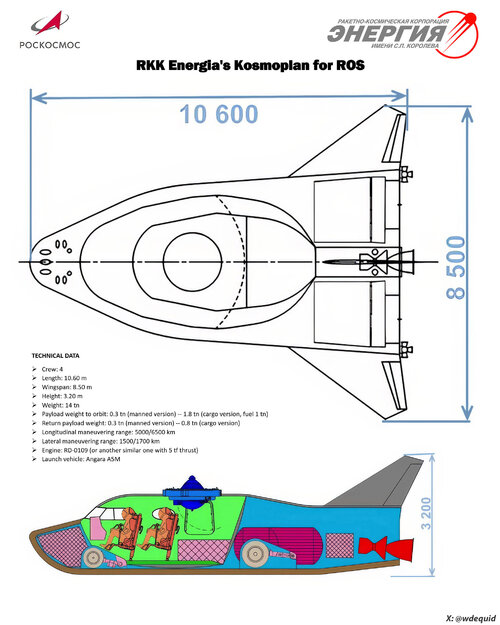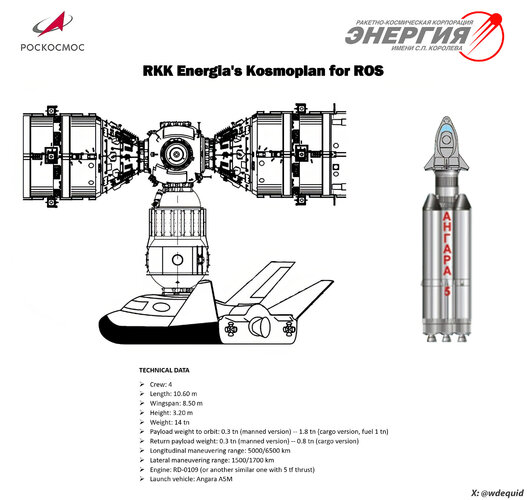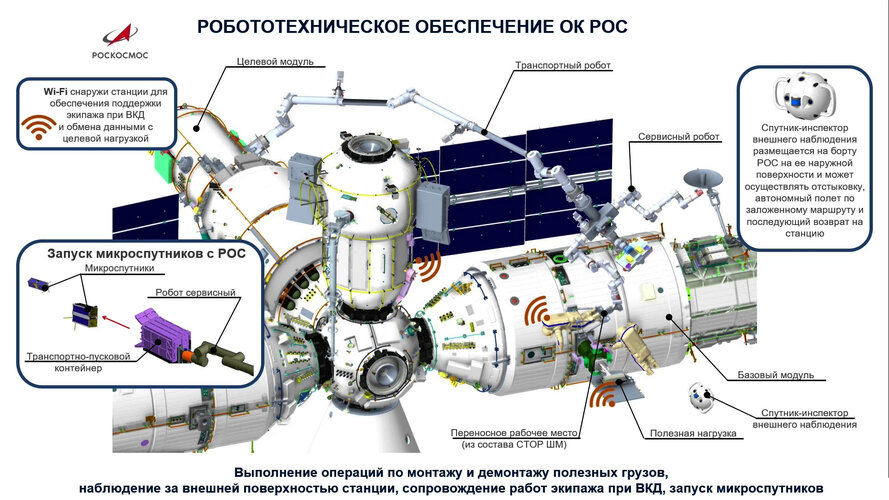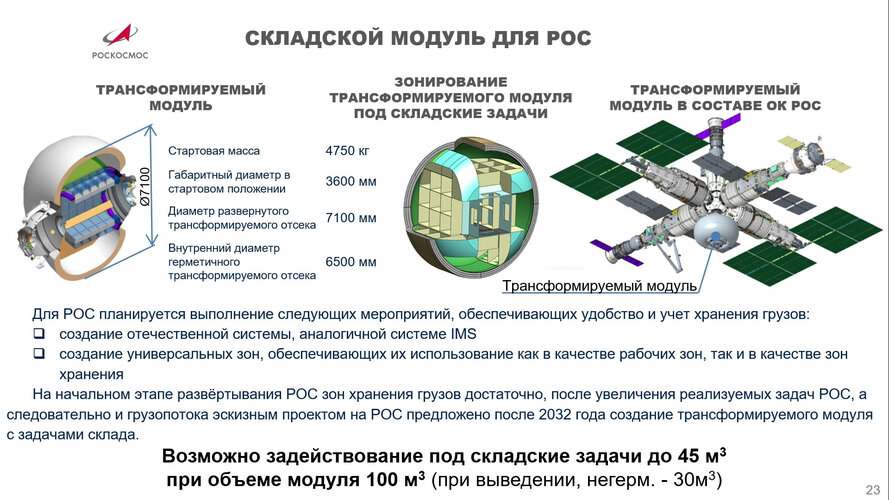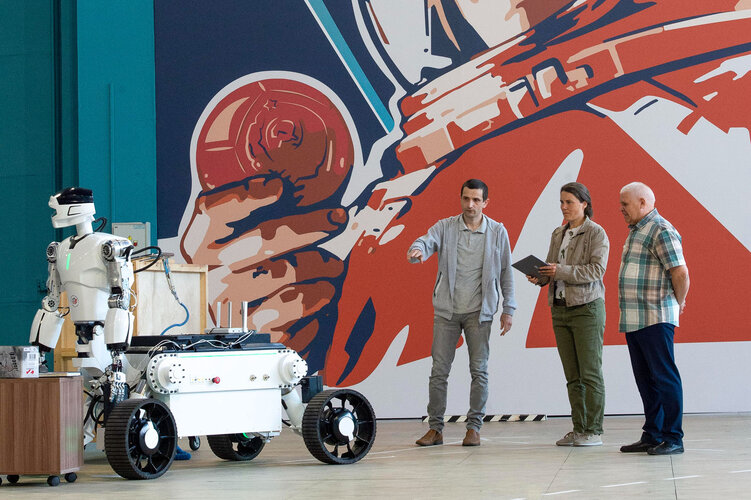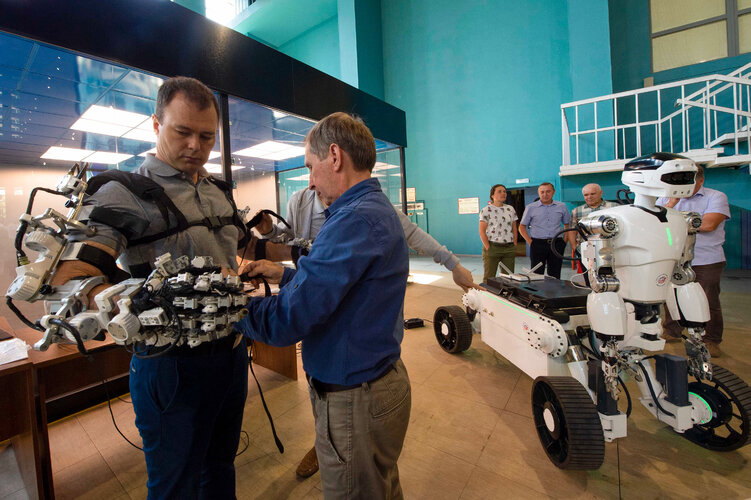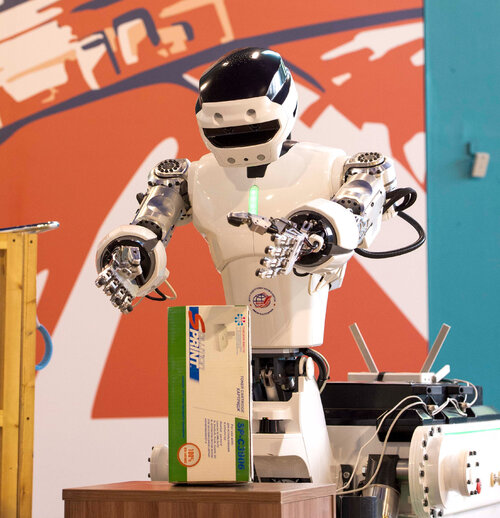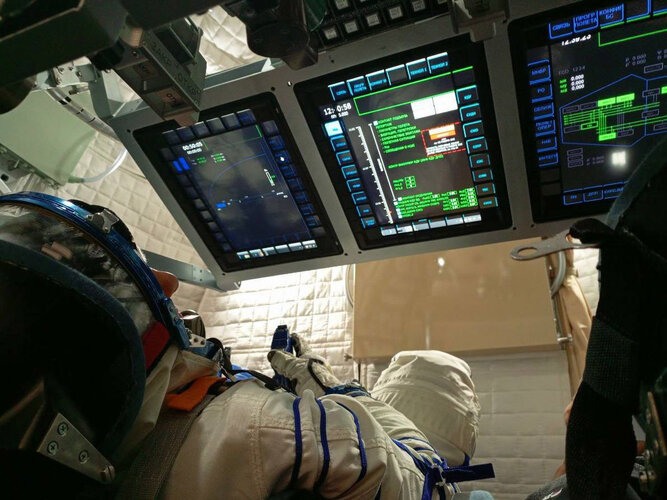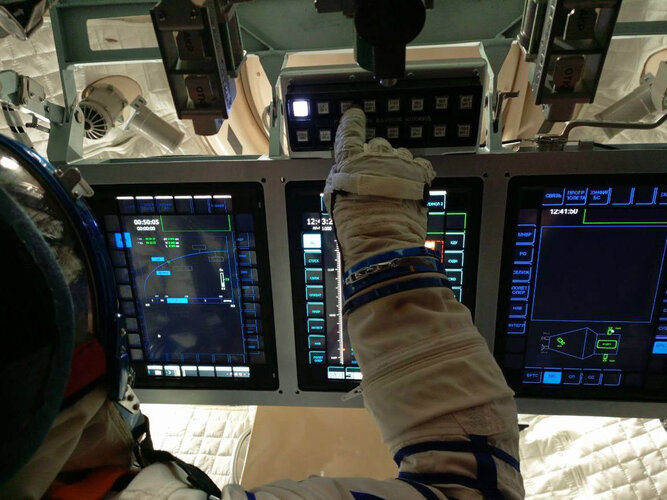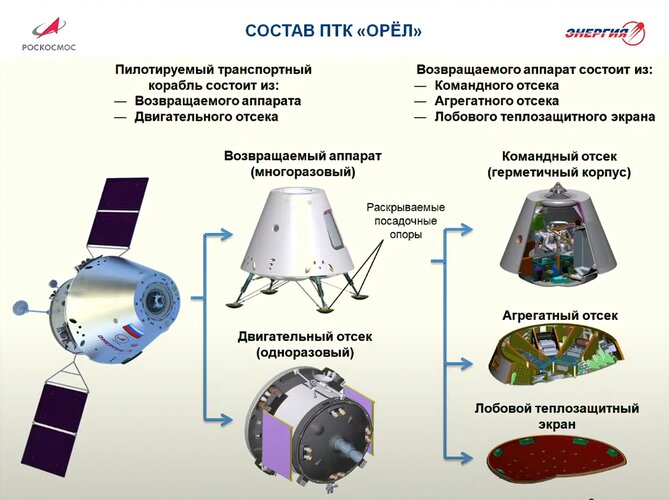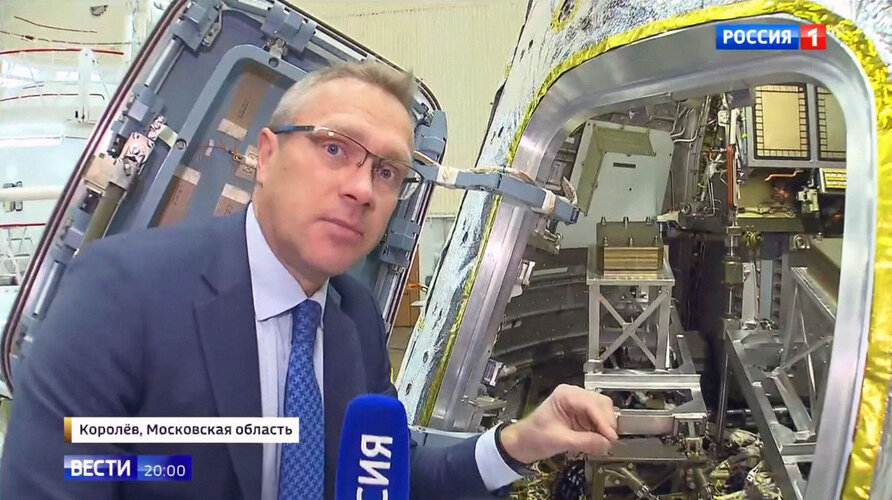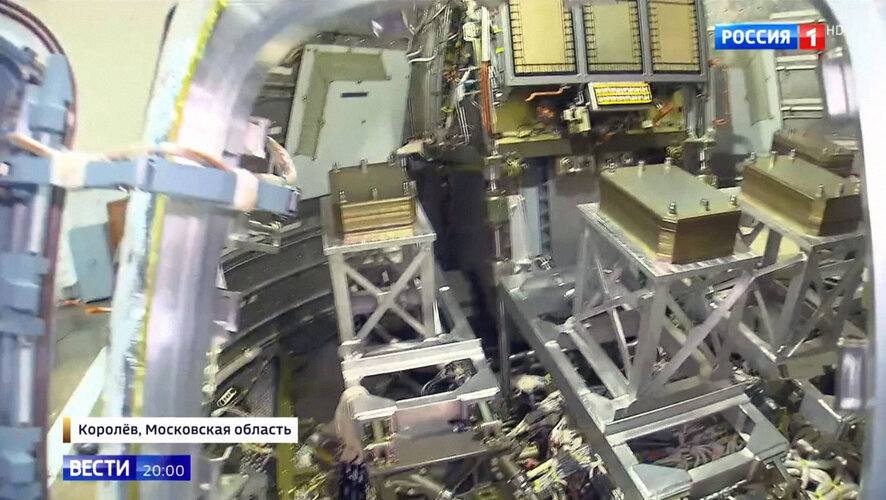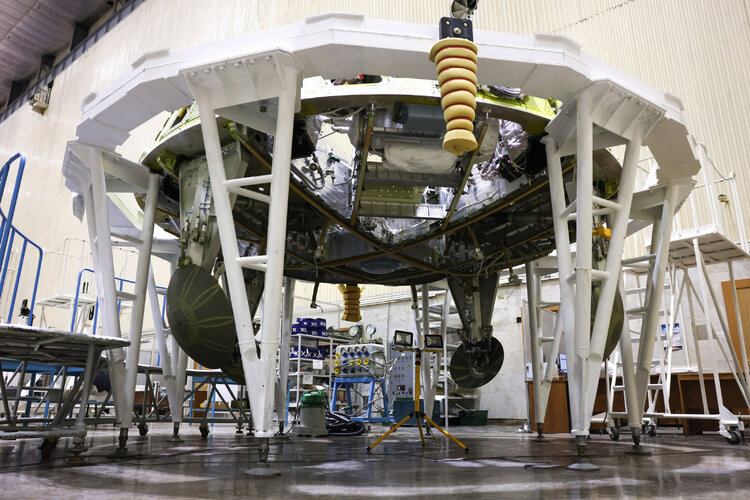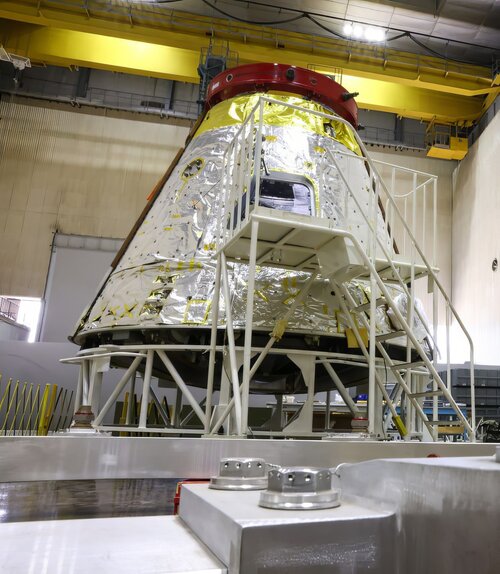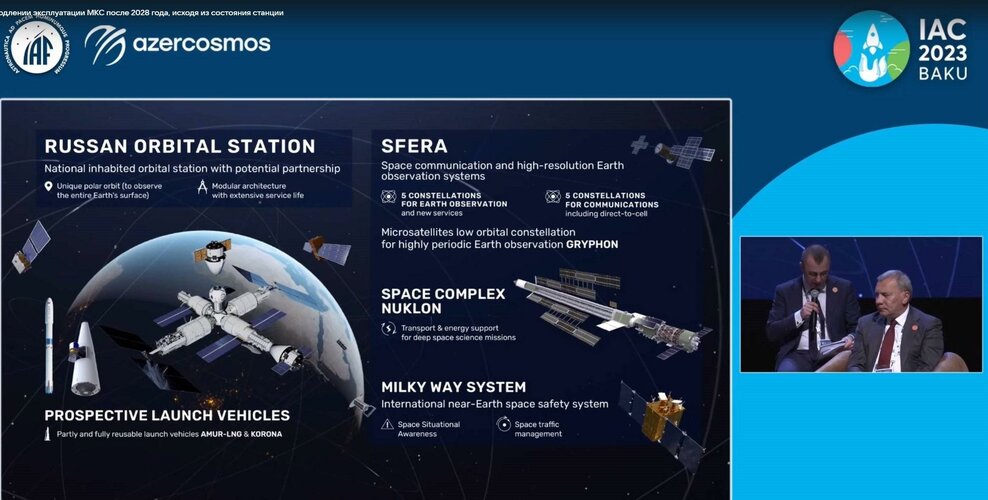You are using an out of date browser. It may not display this or other websites correctly.
You should upgrade or use an alternative browser.
You should upgrade or use an alternative browser.
Russian Space Program
- Thread starter Grey Havoc
- Start date
No, this is self inflicted. Russian hardware quality is crapI hate to see this.
There are times where I wonder if the universe wants to keep us Earthbound...
- Joined
- 21 January 2015
- Messages
- 12,147
- Reaction score
- 16,347
View: https://twitter.com/katlinegrey/status/1714875893468823564
An updated schedule of Russian lunar missions was presented at the 14th International Symposium on Solar System Research. #Luna26 (orbiter) will not be launched earlier, as some of the experts expected. #Luna27 is now scheduled for NET 2028 (instead of 2028) and has a backup.
The #Luna27 backup lander will be launched few months after Luna-27.
- Joined
- 21 January 2015
- Messages
- 12,147
- Reaction score
- 16,347
New article on the failed Luna 25.
 www.leonarddavid.com
www.leonarddavid.com
Russia’s Luna-25 Failed Moon Lander Yields Water Ice Finding
Willythekid
I really should change my personal text
- Joined
- 13 July 2018
- Messages
- 194
- Reaction score
- 1,068
- Joined
- 13 August 2007
- Messages
- 8,445
- Reaction score
- 10,996
Angara-5 rocket first launch from Vostochny, was aborted minutes before launch
Do issue with pressure of Lox tank in core stage
View: https://twitter.com/RussianSpaceWeb/status/1777639440824885445
Do issue with pressure of Lox tank in core stage
View: https://twitter.com/RussianSpaceWeb/status/1777639440824885445
- Joined
- 21 January 2015
- Messages
- 12,147
- Reaction score
- 16,347
From NSF:
The most recent edition of the Center for Strategic & International Studies’ “Space Threat Assessment” report contains a fuzzy picture of Kosmos-2558 taken from another satellite. The report can be downloaded here:
(see p. 18)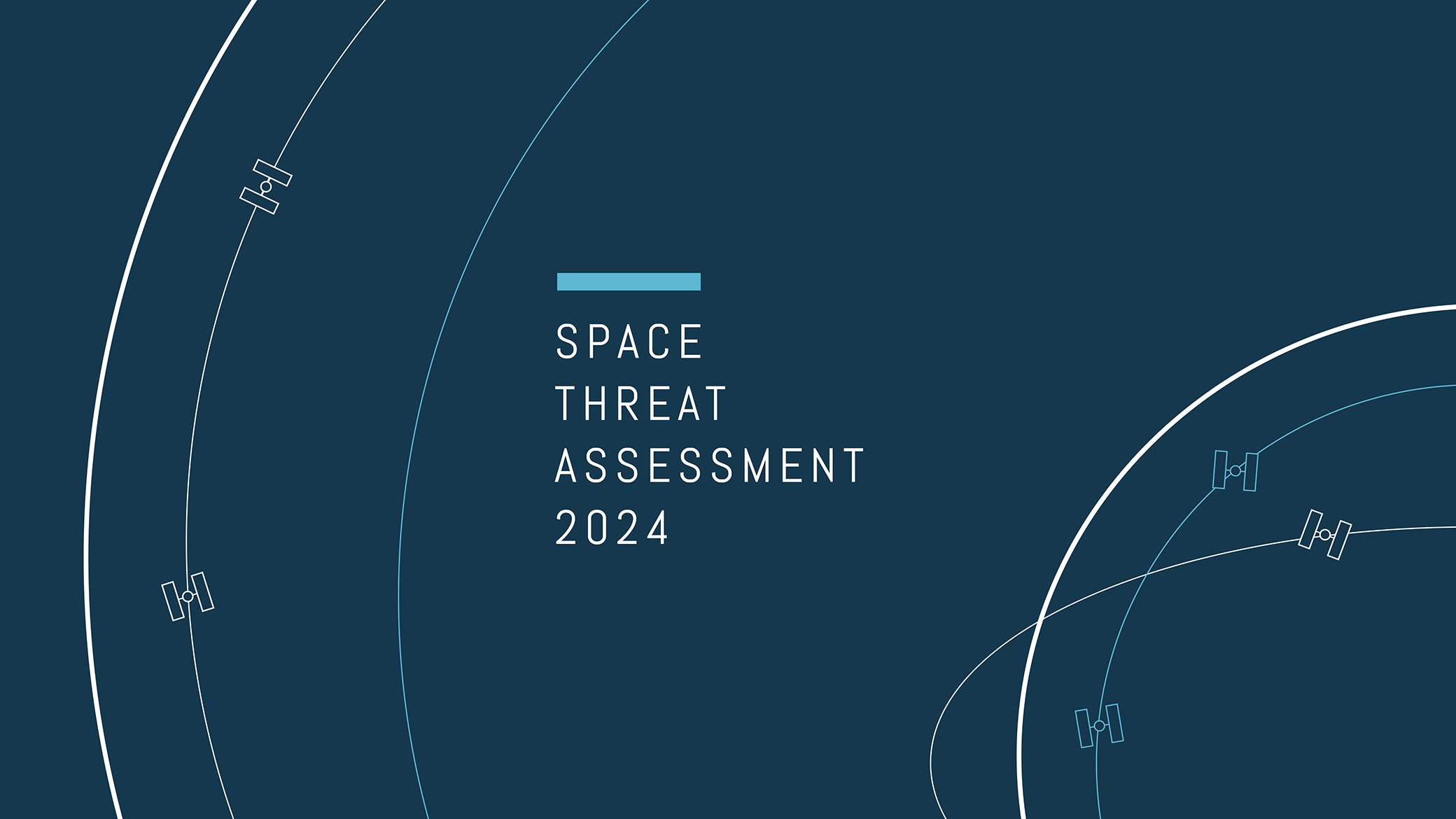
Space Threat Assessment 2024
The 2024 Space Threat Assessment covers the growing counterspace capabilities of China, Russia, India, Iran, North Korea, and others. It also features analysis on the normalization of deviance on orbit and a look into coalitions of convenience that are being formed.www.csis.org
TheKutKu
ACCESS: Secret
- Joined
- 13 February 2023
- Messages
- 464
- Reaction score
- 1,387
- Joined
- 21 January 2015
- Messages
- 12,147
- Reaction score
- 16,347
Willythekid
I really should change my personal text
- Joined
- 13 July 2018
- Messages
- 194
- Reaction score
- 1,068
- Joined
- 13 August 2007
- Messages
- 8,445
- Reaction score
- 10,996
Why they start another Manned Spacecraft Proposal ?Some official information on RKK Energia's new «Kosmoplan»
is there issue or problem with Orel ?
Willythekid
I really should change my personal text
- Joined
- 13 July 2018
- Messages
- 194
- Reaction score
- 1,068
Both the Orel spacecraft and the new ROS station continue their development. On July 2, 2024, Roscosmos head Yuri Borisov signed the assembly plan for the new ROS space station. The Kosmoplan spaceplane I believe is a very long-term proposal.Why they start another Manned Spacecraft Proposal ?
is there issue or problem with Orel ?
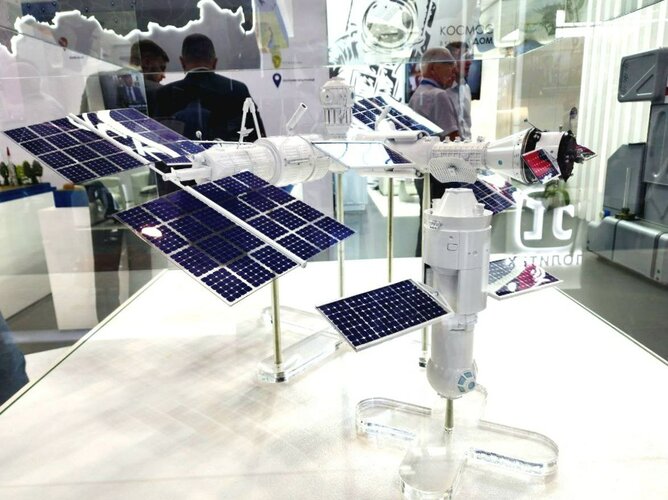
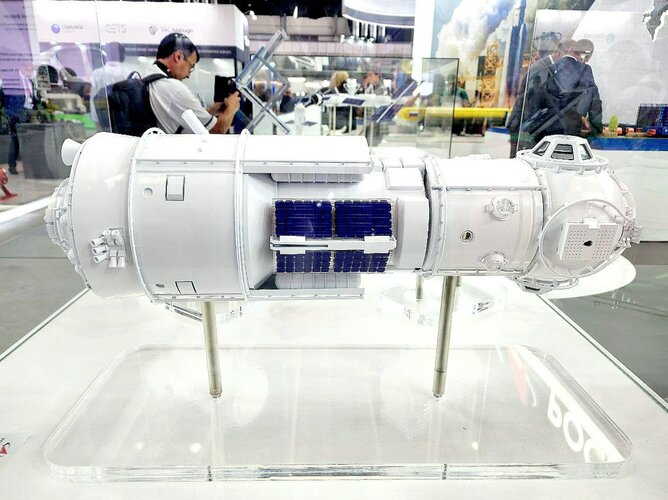
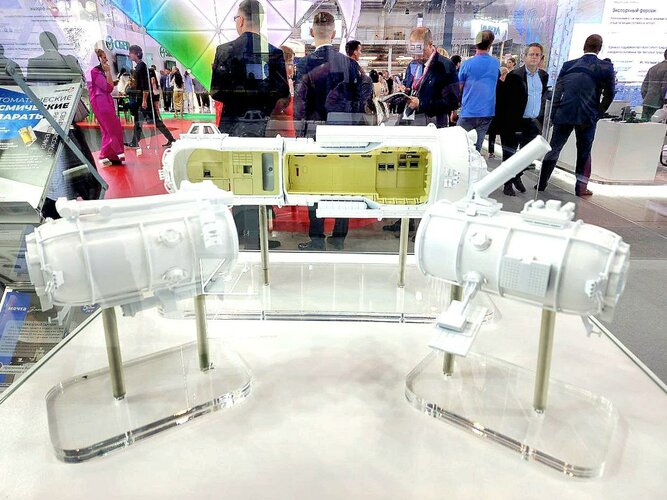

Willythekid
I really should change my personal text
- Joined
- 13 July 2018
- Messages
- 194
- Reaction score
- 1,068
- Joined
- 21 January 2015
- Messages
- 12,147
- Reaction score
- 16,347
LeoLabs reports that the break-up of Resurs-P1 was most likely the result of a "low-intensity explosion" caused by either a debris impact or an internal event.

 www.linkedin.com
www.linkedin.com
LeoLabs on LinkedIn: #resursp1 #leo #spacesafety #spacesustainability
On June 26 EST, we first shared publicly that we had detected a debris-generating event in Low Earth Orbit (LEO). A non-operational Russian spacecraft…
Willythekid
I really should change my personal text
- Joined
- 13 July 2018
- Messages
- 194
- Reaction score
- 1,068
Willythekid
I really should change my personal text
- Joined
- 13 July 2018
- Messages
- 194
- Reaction score
- 1,068
- Joined
- 11 February 2010
- Messages
- 1,650
- Reaction score
- 2,701
I like buttons, better tactile feedback.
- Joined
- 13 August 2007
- Messages
- 8,445
- Reaction score
- 10,996
Current state of Russian spaceflight
(video has Politic content.)
View: https://www.youtube.com/watch?v=zPYcTiDSkYk
(video has Politic content.)
Acatomic
ACCESS: Secret
- Joined
- 18 October 2020
- Messages
- 243
- Reaction score
- 578
JSC GLONASS presented the first Russian wearable mobile satellite communications terminal
JSC GLONASS, the operator of the state information system ERA-GLONASS, presented a prototype of a mobile satellite communication terminal unique in size and characteristics. The development, previously successfully tested for mass civilian use, became part of the project "Import Substitution in the Gas Industry" at the St. Petersburg International Gas Forum.The mobile terminal is already capable of providing personal satellite communications anywhere in Russia by using the resources of existing domestic satellites in geostationary orbit. The solution, before the launch of Russian low-orbit satellite constellations, ensures high-quality import substitution of products from foreign providers that have left the Russian Federation market.
The compact and portable version of the terminal measures 24 cm in width and height, 5 cm in depth, and weighs less than 1.5 kg. The wide beam of the ultra-small antenna simplifies pointing at the satellite and eliminates the complex setup of equipment, as is the case with using satellite dishes. This is the first personal satellite communication solution for mobile objects in Russia, designed to transmit voice and data in real time.
"The mobile satellite communication terminal developed by our team provides two-way voice communication, WiFi connection for smartphones and IoT devices, Internet for instant messengers, mail and exchange of service information, transmission of emergency messages in areas without cellular coverage. We plan to launch serial production of such devices in the near future. The technology and resource of domestic satellites in geostationary orbit cover the existing demand for satellite communications throughout the country. And the key thing is that our solution will ensure the technological sovereignty of Russia and domestic business in the field of navigation and communications," said Alexey Raikevich, General Director of JSC GLONASS .
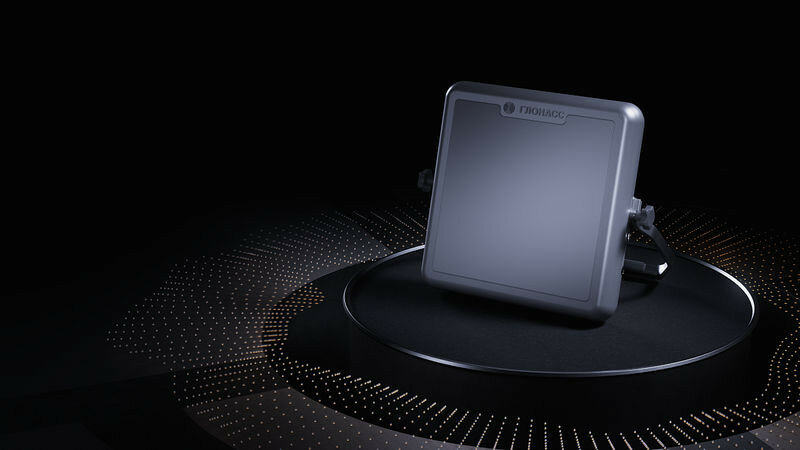
"АО "ГЛОНАСС" презентовало первый российский носимый мобильный терминал спутниковой связи
АО «ГЛОНАСС», оператор госинформсистемы «ЭРА-ГЛОНАСС», представило прототип уникального по размерам и характеристикам мобильного терминала спутниковой связи. Разработка, ранее...
www.ruscable.ru
I snorted my Sunday after church brandy out my nose at this.Nah--that's the intercepted model an Israeli front company sells to Hezbollah.
If you squint, you can make out the words "FRONT TOWARDS ENEMY."
- Joined
- 13 August 2007
- Messages
- 8,445
- Reaction score
- 10,996
- Joined
- 13 August 2007
- Messages
- 8,445
- Reaction score
- 10,996
Willythekid
I really should change my personal text
- Joined
- 13 July 2018
- Messages
- 194
- Reaction score
- 1,068
Rhinocrates
ACCESS: Top Secret
- Joined
- 26 September 2006
- Messages
- 3,053
- Reaction score
- 7,780
Interesting that they're still using landing legs. Seems like a heavy solution versus, say, airbags.
TheKutKu
ACCESS: Secret
- Joined
- 13 February 2023
- Messages
- 464
- Reaction score
- 1,387
It’s hard to use airbags alongside retropropulsive touchdownInteresting that they're still using landing legs. Seems like a heavy solution versus, say, airbags.
Willythekid
I really should change my personal text
- Joined
- 13 July 2018
- Messages
- 194
- Reaction score
- 1,068
So, Spiral programme has its real successor after 40 years?Some official information on RKK Energia's new «Kosmoplan».
Willythekid
I really should change my personal text
- Joined
- 13 July 2018
- Messages
- 194
- Reaction score
- 1,068
Let's hope so!So, Spiral programme has its real successor after 40 years?
Acatomic
ACCESS: Secret
- Joined
- 18 October 2020
- Messages
- 243
- Reaction score
- 578
Manned SSTO Korona would, in my opinion, be more practical. We’ll see what happens with this program.Let's hope so!
Acatomic
ACCESS: Secret
- Joined
- 18 October 2020
- Messages
- 243
- Reaction score
- 578
Interview with the head of Roscosmos:
Via Google translate
Head of Roscosmos — RBC: “Free service is debauchery”
Roscosmos CEO Yuri Borisov revealed details of the new national space project in an interview with RBC TV channel, spoke about the future of the lunar program, the development of new launch vehicles and the Russian analogue of Starlink.
Why Elon Musk's Corporation Has Made as Many Launches in 2024 as Roscosmos Has Made in 11 Years
Of course, the number of launch services that a country carries out per year is an indicator of the development of the national space industry. Musk has been implementing a global project to create the Starlink system for several years now, which requires a large number of satellites in low orbit to provide guaranteed broadband access to a wide range of users. We do not have such projects. We are moving towards building up our own space group, based on our financial and economic capabilities, technological and production.
Roscosmos is currently going through a transition phase, a restructuring of its production model, a transition from stack assembly, that is, single assembly of satellites, to conveyor production, which is precisely what guarantees large-scale serial production, which will require more launch services.
Why Roscosmos Didn't Switch to Conveyor-Based Production of Satellites Earlier
It is very difficult for me to evaluate the actions of my predecessors on this subject. I think that this is, to some extent, an omission, but it probably had objective reasons. The fact is that the entire global space group, practically from the moment of its inception, since the 1960s, when the first satellites were launched, was aimed at paid services. In the West, monetization has always been present. We took a slightly different path and provided services for free. Perhaps this model was appropriate for a planned economy, but in a market economy it is an objective brake on development.
Because a free service is to some extent debauchery. The consumer is not interested in improving quality, they are given it for free anyway. The service provider - what happened, happened, it was for free. Therefore, the path to universal monetization of services required a revision of a number of legislative documents. In particular, a law on the fee for services of remote sensing of the Earth was passed last year.
But the real transition will require filling the budgets of potential users with funds to buy out data, which is practically non-existent today. Who are the users of space services first and foremost? Federal and regional executive authorities and their institutions. Of course, the volume of demand from large businesses is already growing, but the transition period to monetization is difficult and painful, in my opinion, and will not happen instantly. I think it will last for at least two or three years. Here is the law, and because we did not have time to include funds in the 2025 budgets, we were forced to postpone the law, in particular on the fee-based nature of remote sensing of the Earth, until 2026. A year has already been lost.
The industry must move to self-development. Everyone must pay, everyone without exception. The state must stimulate, help with various mechanisms, subsidies or other methods, ensuring the dynamics of development of certain areas.
How to attract private companies to the risky space services market
Fee-based services should initiate the attraction of private companies to this dynamically growing market. After all, in the West, particularly in America, 70% of all space services using multi-satellite constellations are created by private companies. In our country, this process has only just begun. In order for it to have the necessary dynamics, it is necessary to create conditions for private companies. They must understand where they will earn money, what is the profitability of these services. Because the services are high-tech, they require serious and long-term organization of work.
This is a very risky business for potential investors. But what makes them go into this market segment? The fact is that according to forecasts, the space services market will grow dynamically by about 7-8% per year until 2035. This is very serious growth. Space services today ensure the dynamic development of all sectors of the economy and, of course, the country's defense capability. This is what stimulates private companies to invest in satellite construction. This trend is global and stable. In the West, many companies, in particular Elon Musk, even have private spaceports; a private spaceport has already appeared in China. I think that we will gradually come to this.
On state funding of space and the Ministry of Finance’s claims
I will not hide the fact that several years ago there were major complaints about Roscosmos. Because the untimely fulfillment of the undertaken obligations led to the failure to spend the planned funds, and, of course, the Ministry of Finance had objective reasons to simply ask: we plan money for you, but you do not spend it, why should we give it to you? Over the past three years, we have seriously tightened up financial discipline. And today the annual level of spending is approaching 100%. This guarantees the Ministry of Finance that the money is being put to good use, which means that it makes sense to allocate it, it is not squandered, does not go into endless overdue accounts receivable, but is put to use. And therefore, over the past three years, we have been in dialogue with the Ministry of Finance, they are accommodating us. And the planned passport data for the main federal programs are being allocated to us in full.
About the new national space project
I really hope that the new national project, which we are doing on the instructions of the president, will give special momentum to the development of the industry. Work on the national project is in the final stage. It is almost completed, discussed, all the main parameters have been agreed upon. It is already ready for presentation to the president.
It is aimed primarily at creating multi-satellite constellations in cooperation with private companies and provides for a multiple increase in various types of communication constellations, remote sensing of the Earth, low-orbit, geostationary, and highly elliptical.
Of course, this will require the development of advanced launch vehicles, because the most important indicator is the cost of launching cargo into orbit. The lower it is, the better, and the greater the profitability and profitability of players in this market. You can develop a good line of satellites, but if you have expensive launch services due to the high cost of assembling the main launch vehicle, organizing launch services, then you lose all your margin. Therefore, a set of these measures and the restructuring of the production model itself, the transition to conveyor production are the components of the national project that should ensure the dynamic growth of our multi-satellite groups.
We really hope that our proposal will be heard. But everything depends, as you understand, on the financial and economic capabilities of the country. And I think that exactly as much will be allocated for this direction as the country allows. But I believe that this is one of the priority directions for our economy today.
Many conditions will influence the implementation of this project. It provides for a fairly solid attraction of extra-budgetary funds. And extra-budgetary funds in the current economic situation, with a high rate - this is a problem. This means that it is necessary to correctly balance between the methods of support from the state, for example, in our person, private companies, so that they are constantly motivated to invest their own and attracted funds in developments.
At one time, Andrey Removich Belousov and I worked for a long time on the so-called roadmap with private companies. And two main mechanisms were developed that should stimulate private companies to attract funds. This is a guaranteed demand for services, the so-called forward contracts, which guarantee a private company, if obligations are fulfilled and a group is formed, a guaranteed redemption of data. This guarantees payback. And, of course, it is still difficult for them, the state should have lent a shoulder and provided launch services at its own expense. Of course, today it is difficult for private companies to pay for both the launch vehicle and the launch service. These two fundamental principles of work, they are tested by world practice, were laid in the basis of work with private companies. And, of course, universal monetization. These are the main points that were laid in the development of groups with the involvement of private companies.
If we talk about the regulatory framework, I think that a lot has been done. And the very idea of forward contracts is clear to them, transparent and, in principle, is an effective mechanism. Now the dynamics of the development of private space is also affected by the general economic situation, high inflation and high rates, that is, the high cost of money attracted. Let's hope that this is also a temporary period and more favorable times will come.
On the cost of the national space project
There are three scenarios. As always, we work with the Ministry of Finance and the Ministry of Economy: minimum, optimal and maximum. Today it varies from 500 billion to 750 billion. With different proportions of budget and extra-budgetary funds.
Should the state finance space experiments?
Space can and should be commercially oriented and bring real benefits to various industries. It is necessary to correctly use the unique conditions of the absence of gravity of airless space, say, to create new materials, new medical and biological forms of drugs - this can make a very serious contribution to development. It is simply necessary to competently plan experiments not for the sake of experiments, but aiming at practical use. This is a very serious issue. It is necessary not to burn money in order to prove some theorem of existence that will not lead to any commercial success, but to constantly think about the effectiveness of the planned experiments.
How to persuade private investors to invest in Roscosmos and avoid employee jealousy
You can bring them at gunpoint or say: realize your importance. Well, that's stupid, of course. First of all, we need to create real mechanisms that will stimulate capital attraction in certain segments. They should see their benefit. They should see that they invested with certain guarantees and will not go broke. Today, we are in a good dialogue with our private companies. I always meet with them once a month, talk, listen to their aspirations, and try to help them somehow.
Because the current situation is such that we need to eliminate any jealousy that private companies have come without any experience. I won't hide it, many Roscosmos employees had it: how is it that we have been monopolists on the market for years, decades, and then some people came and are doing something. But practice shows that today there is no time for jealousy or arguments. The situation requires that we pool our efforts in order to fill the Russian space group as quickly as possible. All methods are good here.
Basically, private players go to the sweetest segments. Today, the global market is approximately $330 billion per year. According to forecasts, the most dynamically growing segment of the market is the telecommunications market - broadband access, Internet. The volume of this market is predicted to grow approximately threefold by 2030-2035.
A less dynamically growing, but very popular market for remote sensing of the Earth. Moreover, there are never too few remote sensing satellites. Everyone wants to see this or that territory of the Earth as often as possible, with better periodicity, in order to watch for changes in objects or the situation, and with better resolution. And, of course, highly detailed optical and radar reconnaissance services are in demand, which provide all-weather information on a particular object. This is especially important for Russia with its vastness - the connectivity of the population, ensuring guaranteed access to services, the so-called digital equality, remote areas, the Northern Sea Route, they require, of course, the presence of space groups. Only from there can the situation be predicted and some actions taken.
The first swallow. This year we are concluding a contract with Sitronics for the purchase of data, this is already real work.
What are private investors afraid of?
They are interested in two circumstances. These are guarantees of return of invested funds, and, naturally, as in any starting period, they would like to receive certain kinds of benefits at the start. Which is also normal. If we want to develop this direction, first give them something to drink, feed them, and then demand something from them.
On the prospects for the emergence of private spaceports in Russia
Let's first look at satellite construction. Let's see how dynamically our private companies will enter this market segment. Of course, it will require, life itself will tell them that they will think about reducing the cost of launch services. And I hope that companies will appear that will take a risk, like SpaceX did in its time, to develop such a high-tech product as a launch vehicle. And as a result, private spaceports will be needed. I would really like this process to go as quickly as possible in Russia.
On the possibility of postponing the lunar program
It is going according to plan. All events planned in the current federal space program end in 2025. Together with the Academy of Sciences, we are currently drafting proposals for a new program and will defend it in our financial and economic ministries next year. I hope that we will find support.
The program includes the exploration of the Moon by automatic stations. And, as you know, we are participating in an international project together with our Chinese colleagues to create an international scientific lunar station.
About the plans to launch Luna-26
The lunar station must reach the lunar orbit via a slightly different route in 22 days. This is done in order to work out and eliminate all emergency situations at each stage of the transfer orbits, including the one that happened to us with Luna-25. It will be in a polar or near-polar orbit, select a place for future landing and, in fact, perform the function of remote sensing of the Moon, and act as a repeater for transmitting signals for future missions.
About the ISS and the prospects of the Russian orbital station
The ISS has proven its effectiveness, it has been working for 26 years already. The teams of American and European astronauts together with our cosmonauts carry out all the necessary experiments very amicably, despite the political situations that have developed over the years. For them, this does not exist. They work very constructively and amicably, but everything comes to an end.
Today, our cosmonauts are more involved in equipment repair, and there is less and less time left to conduct experiments. And the basic equipment was developed 26 years ago. Of course, the plans together with our American colleagues include deorbiting somewhere around 2030. The final scenario will probably still be clarified, including with the arrival of the new NASA administration. At least, we discussed with the old administration that this was the 2030 milestone. And, in order not to have a break in the manned program, we are simply obliged to replace the Russian segment of the international station with our own domestic one. Although it is called the "Russian Orbital Station", it is an open project, we invite all friendly countries to it and are ready to provide a wide range of participation. From conducting individual scientific experiments to delivering scientific equipment, training astronauts to building individual national modules. Experiments are quite expensive, and we always need to take care of the effectiveness of the invested funds, which is what the Ministry of Finance constantly calls on us to do.
Today, there are more than 90 countries in the world that have their own space agencies. And only three countries have a full range of space technologies, the ability to develop and manufacture launch vehicles, a developed launch infrastructure, spaceports, a manned program, and scientific space - Russia, China, and the United States. And today, the entire world is extremely interested in space, in satellite construction, and in scientific research. My contacts with colleagues in the BRICS countries, with the heads of space agencies, say that this is genuine interest, they are ready to participate in all experiments, they are interested in this. We are discussing this with many countries.
This year we have practically launched large-scale work on the creation of the orbital station. A general schedule has been developed, where all stages of the station's construction are laid out. The main events have been contracted and cooperation has been launched, which is very important. We have already entered into this work in full force.
Of course, everything will depend on resource provision, the Ministry of Finance always has problems, this is natural. But we will somehow find a dialogue with them. The most important thing is to ensure the rhythm of fulfilling the undertaken obligations. Otherwise, if our deadlines slip, a break in the manned program can cost us very dearly - competencies are lost. For example, the Cosmonaut Training Center, if it does not launch, what will it do, who will it train?
The experience, the negative experience of our American colleagues, they shared with us when the shuttles departed and the new carrier had not yet been born, they experienced this moment very painfully and warned us: do not allow a break.
Therefore, today the deadlines for the creation of the Russian station are linked to the completion of the ISS. 2027 - the launch of the first module, then the docking gateway, the base module and the completion of the station. In 2030, it will already be visited, inhabited, and astronauts can fly in and conduct experiments. And the completion will be in 2032. But the very principle of modular construction of this station, which is the basis of the project, it allows these modules to be built up, changed. And therefore, one of the features - long-term, was planned at the start of this object.
On the Impact of a Series of Failures on Roscosmos's Reputation in the World
Space is a field of activity where there is no 100% guaranteed result, and failure haunts everyone. I recently literally read a very serious tome, the history of the formation of Elon Musk's company. His Falcon was the first to have three initial failures. And he practically bet everything on the fourth launch, thank God, it turned out to be successful, and this opened the way for him. But everything was on the thin edge, you could lose the entire business. There are no 100% guarantees. Even when planning lunar missions, we set a 70-80% probability of mission completion at the technical task level. Failures must be steadfastly overcome, conclusions must be drawn and steps forward.
There are world statistics, we are not such leaders in these failures. If you look at the statistics on the implementation of the lunar mission of the United States, Japan, China, India and Russia, I think we are not in last place, but somewhere ahead.
On the postponement of the Angara launch and the Vostochny Cosmodrome
The nerves of all Russians were frayed. We had two delayed launches. It was necessary to explain to everyone, I tried to do it somehow, that these were in fact flight design tests, that this was normal. And if we catch more abnormal situations at the stage of these tests, we will have to spend less effort at the stage of serial operation of the rocket complex. This is a normal phenomenon. All abnormal situations were routine. It was necessary to marry the launch vehicle to the new launch pad, to the new control system. These are natural objective things that were predicted. We took them very calmly. And on April 11, the wonderful launch vehicle left, where it was supposed to. And today we will continue these tests. This indicates that a real infrastructure for launching a heavy carrier has been prepared and tested at Vostochny. This is a serious step.
Such heavy satellites require a carrier that provides the necessary carrying capacity. Research into the outer reaches of space, including the Moon, is practically impossible without a heavy and super-heavy carrier.
We opened space to the world, we were the first to step there, we have a historical responsibility. In my opinion, every Russian has a certain legitimate pride in our past achievements at the genetic level. This obliges us to do a lot today. I am constantly asked: here is Vostochny, how will it develop? As long as Russian cosmonautics and rocket engineering develop, the Russian cosmodrome will develop. This is the president’s project, he himself chose the location for it. And he pays special attention to it. Today, the main infrastructure work has been completed. Two launch pads have been created for launching the medium-class Soyuz and heavy-class Angara launch vehicles.
Work on the airfield complex has been completed, which will greatly simplify our work today. Previously, we all flew to Blagoveshchensk, and it took another hour by helicopter or several hours by car to get to Vostochny. Now we have excellent conditions, an excellent runway, one of the best in the country, which allows us to receive all types of aircraft, including transport aircraft. And only 10-15 minutes from the main premises.
The cosmodrome will develop, and as new launch vehicles are created, new launch pads and new assembly and testing buildings will be created. We associate all plans for the creation of the Russian orbital station with Vostochny - the new Angara launch vehicle, a new manned transport ship, a new cosmodrome and a new station. Everything is new.
On the lack of money for a super-heavy launch vehicle
“The launch of Russia's manned lunar program is being postponed due to a lack of funds to create a super-heavy launch vehicle”, said Oleg Gorshkov, adviser to the general director of Roscosmos, during a congress of young scientists in Sirius in November. "The start dates for manned flights to the Moon are being pushed back due to budgetary restrictions on creating a super-heavy launch vehicle," he said at the time.
Here my adviser was misunderstood and misinterpreted. The fact is that in the current version of the Federal Space Program, we do not provide for the creation of a super-heavy carrier, even in the plans. We are doing preliminary work to develop various types of technologies that will form the basis of a super-heavy carrier. And the plans to create a super-heavy carrier, according to the presidential decree, will be implemented in a separate federal project, the start of which is set for 2026. Of course, we will work and are working today, we continue to work on the main solutions for the super-heavy, because deep space exploration, conducting scientific experiments, flights to distant planets are impossible without a super-heavy carrier. I will not hide that this is not a cheap undertaking.
On the timing of the appearance of the Russian analogue of Starlink
It is not an end in itself to chase and achieve some records in this regard today. We need to think about quality and provision of at least the minimum required volume of services in the interests of the economy, defense and security. A project similar to Starlink is being implemented by Bureau 1440. Broadband services will be provided in low orbits. And in addition to this service, we are developing the Skif space group, we launched the demonstrator of the device back in the fall of 2022, it proved the orbital-frequency resource, protected the orbital-frequency resource. The equipment confirmed its flight suitability. But these are medium orbits. They will complement each other.
I hope that there will be more private companies like Bureau 1440 that will take the risk of entering this interesting market segment and will implement their plans. They exist, but they need to be nurtured and cherished today. They need to be licked so that they can really seriously enter this market segment.
Russians will be able to connect to the Russian analogue of Starlink by 2030, guaranteed, maybe in 2028-2029.
Source: https://www.rbc.ru/interview/technology_and_media/09/12/2024/675671c39a794769f2b2d272
Via Google translate
Head of Roscosmos — RBC: “Free service is debauchery”
Roscosmos CEO Yuri Borisov revealed details of the new national space project in an interview with RBC TV channel, spoke about the future of the lunar program, the development of new launch vehicles and the Russian analogue of Starlink.
Why Elon Musk's Corporation Has Made as Many Launches in 2024 as Roscosmos Has Made in 11 Years
Of course, the number of launch services that a country carries out per year is an indicator of the development of the national space industry. Musk has been implementing a global project to create the Starlink system for several years now, which requires a large number of satellites in low orbit to provide guaranteed broadband access to a wide range of users. We do not have such projects. We are moving towards building up our own space group, based on our financial and economic capabilities, technological and production.
Roscosmos is currently going through a transition phase, a restructuring of its production model, a transition from stack assembly, that is, single assembly of satellites, to conveyor production, which is precisely what guarantees large-scale serial production, which will require more launch services.
Why Roscosmos Didn't Switch to Conveyor-Based Production of Satellites Earlier
It is very difficult for me to evaluate the actions of my predecessors on this subject. I think that this is, to some extent, an omission, but it probably had objective reasons. The fact is that the entire global space group, practically from the moment of its inception, since the 1960s, when the first satellites were launched, was aimed at paid services. In the West, monetization has always been present. We took a slightly different path and provided services for free. Perhaps this model was appropriate for a planned economy, but in a market economy it is an objective brake on development.
Because a free service is to some extent debauchery. The consumer is not interested in improving quality, they are given it for free anyway. The service provider - what happened, happened, it was for free. Therefore, the path to universal monetization of services required a revision of a number of legislative documents. In particular, a law on the fee for services of remote sensing of the Earth was passed last year.
But the real transition will require filling the budgets of potential users with funds to buy out data, which is practically non-existent today. Who are the users of space services first and foremost? Federal and regional executive authorities and their institutions. Of course, the volume of demand from large businesses is already growing, but the transition period to monetization is difficult and painful, in my opinion, and will not happen instantly. I think it will last for at least two or three years. Here is the law, and because we did not have time to include funds in the 2025 budgets, we were forced to postpone the law, in particular on the fee-based nature of remote sensing of the Earth, until 2026. A year has already been lost.
The industry must move to self-development. Everyone must pay, everyone without exception. The state must stimulate, help with various mechanisms, subsidies or other methods, ensuring the dynamics of development of certain areas.
How to attract private companies to the risky space services market
Fee-based services should initiate the attraction of private companies to this dynamically growing market. After all, in the West, particularly in America, 70% of all space services using multi-satellite constellations are created by private companies. In our country, this process has only just begun. In order for it to have the necessary dynamics, it is necessary to create conditions for private companies. They must understand where they will earn money, what is the profitability of these services. Because the services are high-tech, they require serious and long-term organization of work.
This is a very risky business for potential investors. But what makes them go into this market segment? The fact is that according to forecasts, the space services market will grow dynamically by about 7-8% per year until 2035. This is very serious growth. Space services today ensure the dynamic development of all sectors of the economy and, of course, the country's defense capability. This is what stimulates private companies to invest in satellite construction. This trend is global and stable. In the West, many companies, in particular Elon Musk, even have private spaceports; a private spaceport has already appeared in China. I think that we will gradually come to this.
On state funding of space and the Ministry of Finance’s claims
I will not hide the fact that several years ago there were major complaints about Roscosmos. Because the untimely fulfillment of the undertaken obligations led to the failure to spend the planned funds, and, of course, the Ministry of Finance had objective reasons to simply ask: we plan money for you, but you do not spend it, why should we give it to you? Over the past three years, we have seriously tightened up financial discipline. And today the annual level of spending is approaching 100%. This guarantees the Ministry of Finance that the money is being put to good use, which means that it makes sense to allocate it, it is not squandered, does not go into endless overdue accounts receivable, but is put to use. And therefore, over the past three years, we have been in dialogue with the Ministry of Finance, they are accommodating us. And the planned passport data for the main federal programs are being allocated to us in full.
About the new national space project
I really hope that the new national project, which we are doing on the instructions of the president, will give special momentum to the development of the industry. Work on the national project is in the final stage. It is almost completed, discussed, all the main parameters have been agreed upon. It is already ready for presentation to the president.
It is aimed primarily at creating multi-satellite constellations in cooperation with private companies and provides for a multiple increase in various types of communication constellations, remote sensing of the Earth, low-orbit, geostationary, and highly elliptical.
Of course, this will require the development of advanced launch vehicles, because the most important indicator is the cost of launching cargo into orbit. The lower it is, the better, and the greater the profitability and profitability of players in this market. You can develop a good line of satellites, but if you have expensive launch services due to the high cost of assembling the main launch vehicle, organizing launch services, then you lose all your margin. Therefore, a set of these measures and the restructuring of the production model itself, the transition to conveyor production are the components of the national project that should ensure the dynamic growth of our multi-satellite groups.
We really hope that our proposal will be heard. But everything depends, as you understand, on the financial and economic capabilities of the country. And I think that exactly as much will be allocated for this direction as the country allows. But I believe that this is one of the priority directions for our economy today.
Many conditions will influence the implementation of this project. It provides for a fairly solid attraction of extra-budgetary funds. And extra-budgetary funds in the current economic situation, with a high rate - this is a problem. This means that it is necessary to correctly balance between the methods of support from the state, for example, in our person, private companies, so that they are constantly motivated to invest their own and attracted funds in developments.
At one time, Andrey Removich Belousov and I worked for a long time on the so-called roadmap with private companies. And two main mechanisms were developed that should stimulate private companies to attract funds. This is a guaranteed demand for services, the so-called forward contracts, which guarantee a private company, if obligations are fulfilled and a group is formed, a guaranteed redemption of data. This guarantees payback. And, of course, it is still difficult for them, the state should have lent a shoulder and provided launch services at its own expense. Of course, today it is difficult for private companies to pay for both the launch vehicle and the launch service. These two fundamental principles of work, they are tested by world practice, were laid in the basis of work with private companies. And, of course, universal monetization. These are the main points that were laid in the development of groups with the involvement of private companies.
If we talk about the regulatory framework, I think that a lot has been done. And the very idea of forward contracts is clear to them, transparent and, in principle, is an effective mechanism. Now the dynamics of the development of private space is also affected by the general economic situation, high inflation and high rates, that is, the high cost of money attracted. Let's hope that this is also a temporary period and more favorable times will come.
On the cost of the national space project
There are three scenarios. As always, we work with the Ministry of Finance and the Ministry of Economy: minimum, optimal and maximum. Today it varies from 500 billion to 750 billion. With different proportions of budget and extra-budgetary funds.
Should the state finance space experiments?
Space can and should be commercially oriented and bring real benefits to various industries. It is necessary to correctly use the unique conditions of the absence of gravity of airless space, say, to create new materials, new medical and biological forms of drugs - this can make a very serious contribution to development. It is simply necessary to competently plan experiments not for the sake of experiments, but aiming at practical use. This is a very serious issue. It is necessary not to burn money in order to prove some theorem of existence that will not lead to any commercial success, but to constantly think about the effectiveness of the planned experiments.
How to persuade private investors to invest in Roscosmos and avoid employee jealousy
You can bring them at gunpoint or say: realize your importance. Well, that's stupid, of course. First of all, we need to create real mechanisms that will stimulate capital attraction in certain segments. They should see their benefit. They should see that they invested with certain guarantees and will not go broke. Today, we are in a good dialogue with our private companies. I always meet with them once a month, talk, listen to their aspirations, and try to help them somehow.
Because the current situation is such that we need to eliminate any jealousy that private companies have come without any experience. I won't hide it, many Roscosmos employees had it: how is it that we have been monopolists on the market for years, decades, and then some people came and are doing something. But practice shows that today there is no time for jealousy or arguments. The situation requires that we pool our efforts in order to fill the Russian space group as quickly as possible. All methods are good here.
Basically, private players go to the sweetest segments. Today, the global market is approximately $330 billion per year. According to forecasts, the most dynamically growing segment of the market is the telecommunications market - broadband access, Internet. The volume of this market is predicted to grow approximately threefold by 2030-2035.
A less dynamically growing, but very popular market for remote sensing of the Earth. Moreover, there are never too few remote sensing satellites. Everyone wants to see this or that territory of the Earth as often as possible, with better periodicity, in order to watch for changes in objects or the situation, and with better resolution. And, of course, highly detailed optical and radar reconnaissance services are in demand, which provide all-weather information on a particular object. This is especially important for Russia with its vastness - the connectivity of the population, ensuring guaranteed access to services, the so-called digital equality, remote areas, the Northern Sea Route, they require, of course, the presence of space groups. Only from there can the situation be predicted and some actions taken.
The first swallow. This year we are concluding a contract with Sitronics for the purchase of data, this is already real work.
What are private investors afraid of?
They are interested in two circumstances. These are guarantees of return of invested funds, and, naturally, as in any starting period, they would like to receive certain kinds of benefits at the start. Which is also normal. If we want to develop this direction, first give them something to drink, feed them, and then demand something from them.
On the prospects for the emergence of private spaceports in Russia
Let's first look at satellite construction. Let's see how dynamically our private companies will enter this market segment. Of course, it will require, life itself will tell them that they will think about reducing the cost of launch services. And I hope that companies will appear that will take a risk, like SpaceX did in its time, to develop such a high-tech product as a launch vehicle. And as a result, private spaceports will be needed. I would really like this process to go as quickly as possible in Russia.
On the possibility of postponing the lunar program
It is going according to plan. All events planned in the current federal space program end in 2025. Together with the Academy of Sciences, we are currently drafting proposals for a new program and will defend it in our financial and economic ministries next year. I hope that we will find support.
The program includes the exploration of the Moon by automatic stations. And, as you know, we are participating in an international project together with our Chinese colleagues to create an international scientific lunar station.
About the plans to launch Luna-26
The lunar station must reach the lunar orbit via a slightly different route in 22 days. This is done in order to work out and eliminate all emergency situations at each stage of the transfer orbits, including the one that happened to us with Luna-25. It will be in a polar or near-polar orbit, select a place for future landing and, in fact, perform the function of remote sensing of the Moon, and act as a repeater for transmitting signals for future missions.
About the ISS and the prospects of the Russian orbital station
The ISS has proven its effectiveness, it has been working for 26 years already. The teams of American and European astronauts together with our cosmonauts carry out all the necessary experiments very amicably, despite the political situations that have developed over the years. For them, this does not exist. They work very constructively and amicably, but everything comes to an end.
Today, our cosmonauts are more involved in equipment repair, and there is less and less time left to conduct experiments. And the basic equipment was developed 26 years ago. Of course, the plans together with our American colleagues include deorbiting somewhere around 2030. The final scenario will probably still be clarified, including with the arrival of the new NASA administration. At least, we discussed with the old administration that this was the 2030 milestone. And, in order not to have a break in the manned program, we are simply obliged to replace the Russian segment of the international station with our own domestic one. Although it is called the "Russian Orbital Station", it is an open project, we invite all friendly countries to it and are ready to provide a wide range of participation. From conducting individual scientific experiments to delivering scientific equipment, training astronauts to building individual national modules. Experiments are quite expensive, and we always need to take care of the effectiveness of the invested funds, which is what the Ministry of Finance constantly calls on us to do.
Today, there are more than 90 countries in the world that have their own space agencies. And only three countries have a full range of space technologies, the ability to develop and manufacture launch vehicles, a developed launch infrastructure, spaceports, a manned program, and scientific space - Russia, China, and the United States. And today, the entire world is extremely interested in space, in satellite construction, and in scientific research. My contacts with colleagues in the BRICS countries, with the heads of space agencies, say that this is genuine interest, they are ready to participate in all experiments, they are interested in this. We are discussing this with many countries.
This year we have practically launched large-scale work on the creation of the orbital station. A general schedule has been developed, where all stages of the station's construction are laid out. The main events have been contracted and cooperation has been launched, which is very important. We have already entered into this work in full force.
Of course, everything will depend on resource provision, the Ministry of Finance always has problems, this is natural. But we will somehow find a dialogue with them. The most important thing is to ensure the rhythm of fulfilling the undertaken obligations. Otherwise, if our deadlines slip, a break in the manned program can cost us very dearly - competencies are lost. For example, the Cosmonaut Training Center, if it does not launch, what will it do, who will it train?
The experience, the negative experience of our American colleagues, they shared with us when the shuttles departed and the new carrier had not yet been born, they experienced this moment very painfully and warned us: do not allow a break.
Therefore, today the deadlines for the creation of the Russian station are linked to the completion of the ISS. 2027 - the launch of the first module, then the docking gateway, the base module and the completion of the station. In 2030, it will already be visited, inhabited, and astronauts can fly in and conduct experiments. And the completion will be in 2032. But the very principle of modular construction of this station, which is the basis of the project, it allows these modules to be built up, changed. And therefore, one of the features - long-term, was planned at the start of this object.
On the Impact of a Series of Failures on Roscosmos's Reputation in the World
Space is a field of activity where there is no 100% guaranteed result, and failure haunts everyone. I recently literally read a very serious tome, the history of the formation of Elon Musk's company. His Falcon was the first to have three initial failures. And he practically bet everything on the fourth launch, thank God, it turned out to be successful, and this opened the way for him. But everything was on the thin edge, you could lose the entire business. There are no 100% guarantees. Even when planning lunar missions, we set a 70-80% probability of mission completion at the technical task level. Failures must be steadfastly overcome, conclusions must be drawn and steps forward.
There are world statistics, we are not such leaders in these failures. If you look at the statistics on the implementation of the lunar mission of the United States, Japan, China, India and Russia, I think we are not in last place, but somewhere ahead.
On the postponement of the Angara launch and the Vostochny Cosmodrome
The nerves of all Russians were frayed. We had two delayed launches. It was necessary to explain to everyone, I tried to do it somehow, that these were in fact flight design tests, that this was normal. And if we catch more abnormal situations at the stage of these tests, we will have to spend less effort at the stage of serial operation of the rocket complex. This is a normal phenomenon. All abnormal situations were routine. It was necessary to marry the launch vehicle to the new launch pad, to the new control system. These are natural objective things that were predicted. We took them very calmly. And on April 11, the wonderful launch vehicle left, where it was supposed to. And today we will continue these tests. This indicates that a real infrastructure for launching a heavy carrier has been prepared and tested at Vostochny. This is a serious step.
Such heavy satellites require a carrier that provides the necessary carrying capacity. Research into the outer reaches of space, including the Moon, is practically impossible without a heavy and super-heavy carrier.
We opened space to the world, we were the first to step there, we have a historical responsibility. In my opinion, every Russian has a certain legitimate pride in our past achievements at the genetic level. This obliges us to do a lot today. I am constantly asked: here is Vostochny, how will it develop? As long as Russian cosmonautics and rocket engineering develop, the Russian cosmodrome will develop. This is the president’s project, he himself chose the location for it. And he pays special attention to it. Today, the main infrastructure work has been completed. Two launch pads have been created for launching the medium-class Soyuz and heavy-class Angara launch vehicles.
Work on the airfield complex has been completed, which will greatly simplify our work today. Previously, we all flew to Blagoveshchensk, and it took another hour by helicopter or several hours by car to get to Vostochny. Now we have excellent conditions, an excellent runway, one of the best in the country, which allows us to receive all types of aircraft, including transport aircraft. And only 10-15 minutes from the main premises.
The cosmodrome will develop, and as new launch vehicles are created, new launch pads and new assembly and testing buildings will be created. We associate all plans for the creation of the Russian orbital station with Vostochny - the new Angara launch vehicle, a new manned transport ship, a new cosmodrome and a new station. Everything is new.
On the lack of money for a super-heavy launch vehicle
“The launch of Russia's manned lunar program is being postponed due to a lack of funds to create a super-heavy launch vehicle”, said Oleg Gorshkov, adviser to the general director of Roscosmos, during a congress of young scientists in Sirius in November. "The start dates for manned flights to the Moon are being pushed back due to budgetary restrictions on creating a super-heavy launch vehicle," he said at the time.
Here my adviser was misunderstood and misinterpreted. The fact is that in the current version of the Federal Space Program, we do not provide for the creation of a super-heavy carrier, even in the plans. We are doing preliminary work to develop various types of technologies that will form the basis of a super-heavy carrier. And the plans to create a super-heavy carrier, according to the presidential decree, will be implemented in a separate federal project, the start of which is set for 2026. Of course, we will work and are working today, we continue to work on the main solutions for the super-heavy, because deep space exploration, conducting scientific experiments, flights to distant planets are impossible without a super-heavy carrier. I will not hide that this is not a cheap undertaking.
On the timing of the appearance of the Russian analogue of Starlink
It is not an end in itself to chase and achieve some records in this regard today. We need to think about quality and provision of at least the minimum required volume of services in the interests of the economy, defense and security. A project similar to Starlink is being implemented by Bureau 1440. Broadband services will be provided in low orbits. And in addition to this service, we are developing the Skif space group, we launched the demonstrator of the device back in the fall of 2022, it proved the orbital-frequency resource, protected the orbital-frequency resource. The equipment confirmed its flight suitability. But these are medium orbits. They will complement each other.
I hope that there will be more private companies like Bureau 1440 that will take the risk of entering this interesting market segment and will implement their plans. They exist, but they need to be nurtured and cherished today. They need to be licked so that they can really seriously enter this market segment.
Russians will be able to connect to the Russian analogue of Starlink by 2030, guaranteed, maybe in 2028-2029.
Source: https://www.rbc.ru/interview/technology_and_media/09/12/2024/675671c39a794769f2b2d272
- Joined
- 21 January 2015
- Messages
- 12,147
- Reaction score
- 16,347
View: https://twitter.com/sciguyspace/status/1869386427991232690

 arstechnica.com
arstechnica.com
Russia appears ready to commit to the International Space Station to NASA's desired timeline of 2030.

Russian space chief says country will fly on space station until 2030
“Space is an area of activity where there is never a 100 percent guaranteed result.”…
 arstechnica.com
arstechnica.com
Dilandu
I'm dissatisfied, which means, I exist.
Nuklon is basically dead. The reactor development might be salvaged to joint lunar powerplant project with Chinese.I think this screenshot nicely sums up Russian space program in the next 10 years:
Acatomic
ACCESS: Secret
- Joined
- 18 October 2020
- Messages
- 243
- Reaction score
- 578
Really? Just a month ago head of Roscosmos was saying that it was going along just fine:
The head of Roscosmos also said that the nuclear tug Zeus, which is being developed in Russia, is planned to be used for the exploration of deep space. Its prototype is planned to be created in 2030. “We are doing this project on our own for now, and it is going quite well. The corresponding reactor capacities have been achieved. And I think that we will not stop work in this direction, and somewhere in the 2030s–40s the product will already be practically used for the exploration of deep space, for scientific programs,” Borisov said.
Similar threads
-
-
-
The second launch from Russia’s new spaceport has failed
- Started by Flyaway
- Replies: 5
-
-

